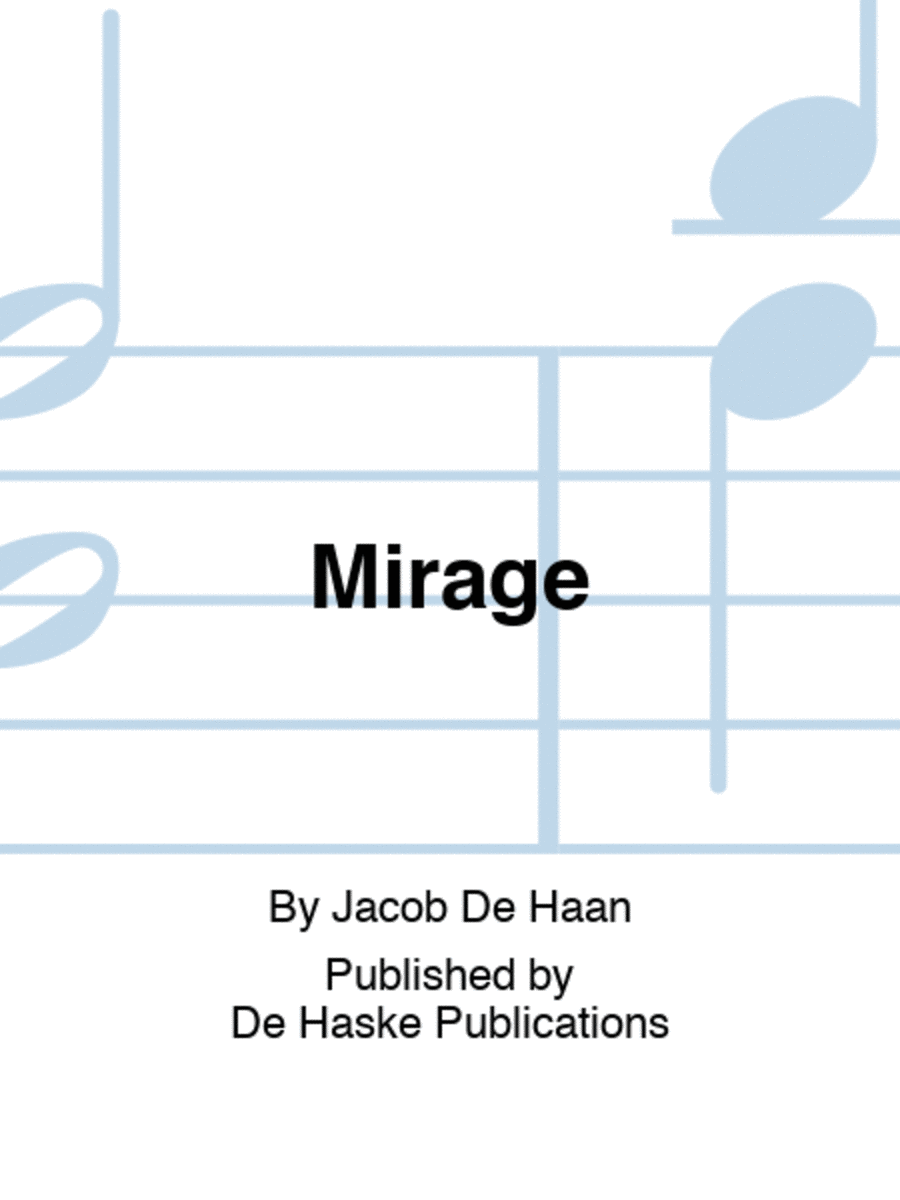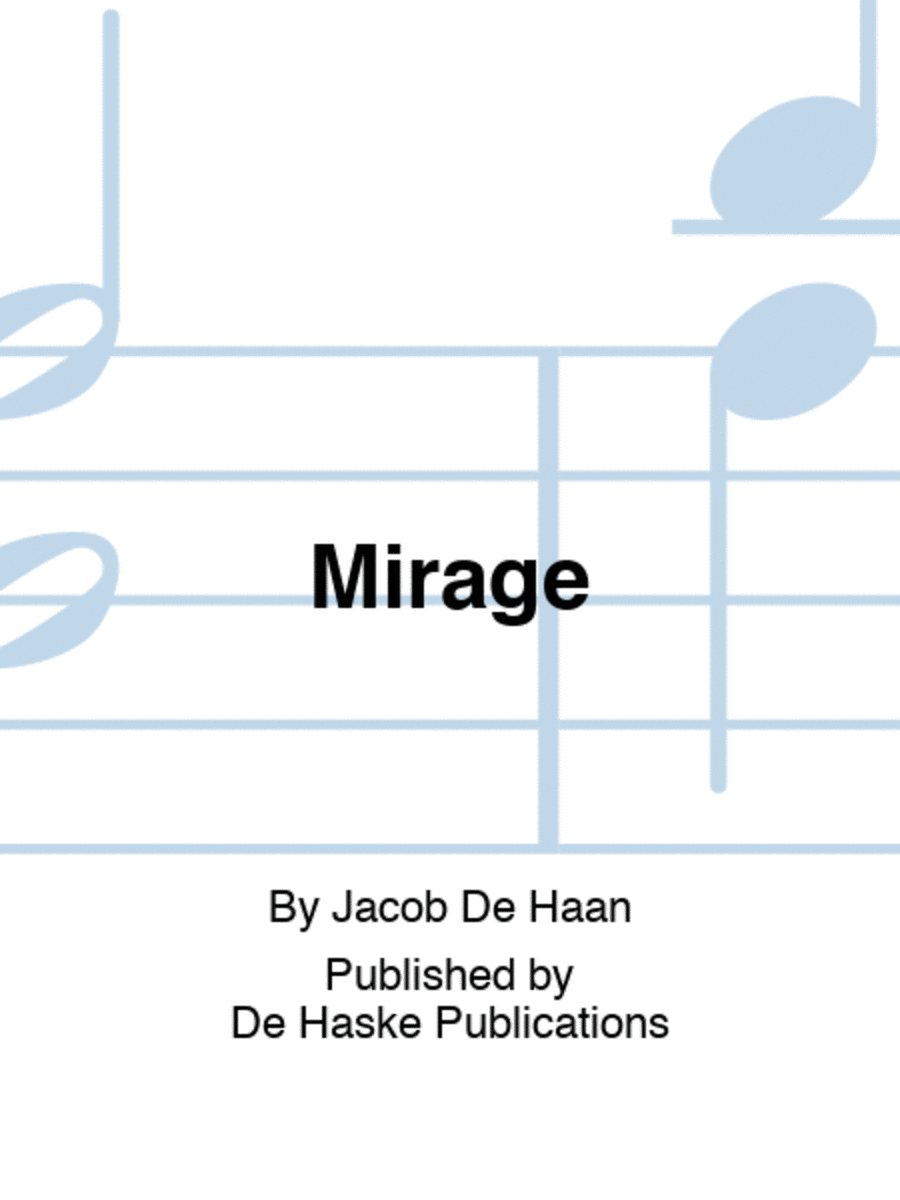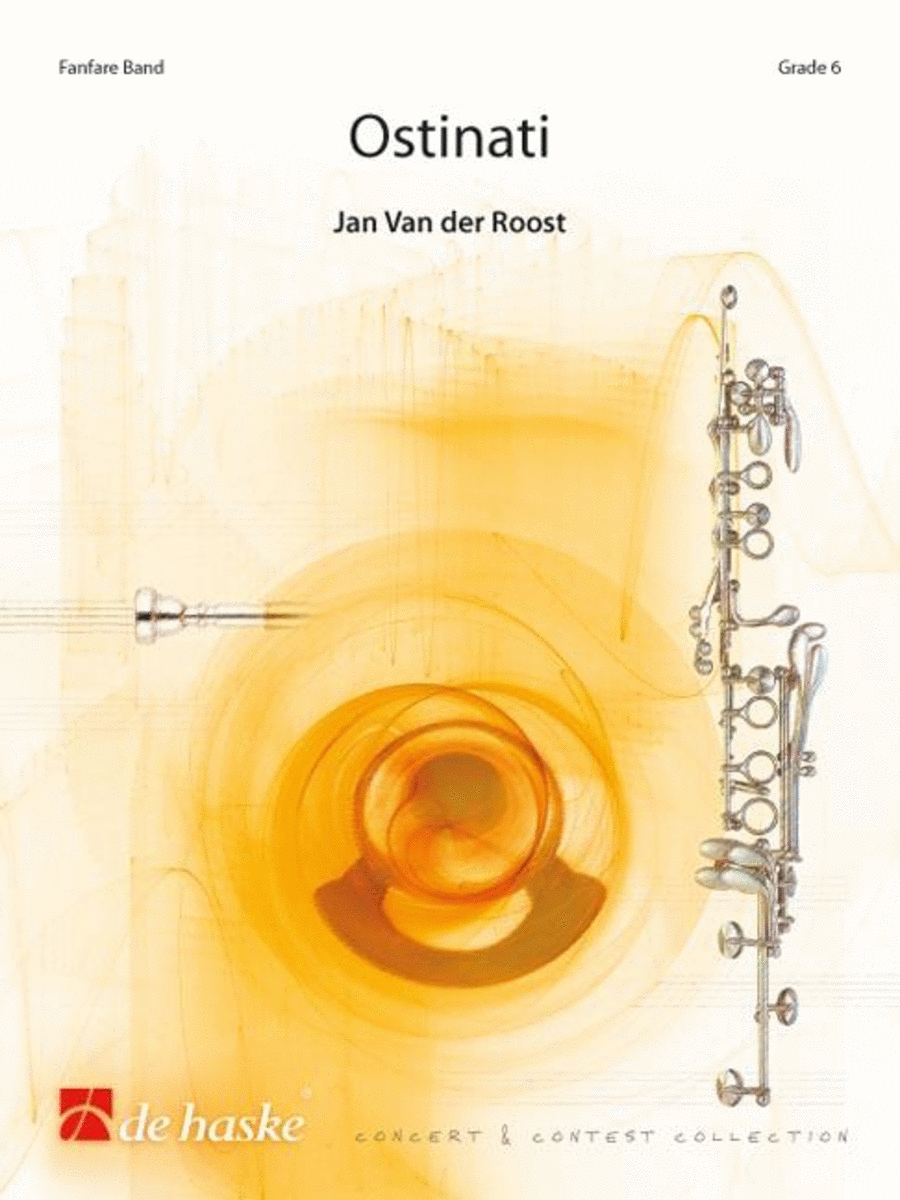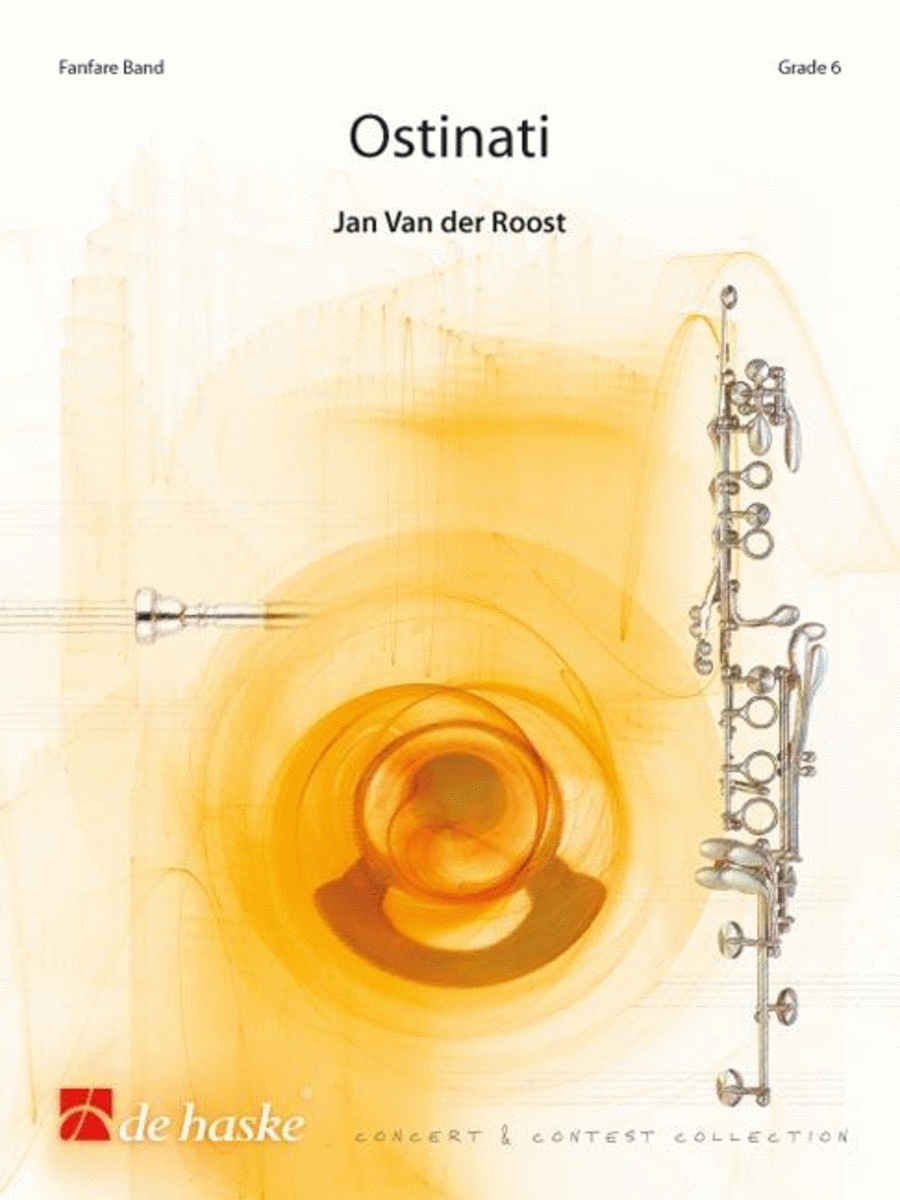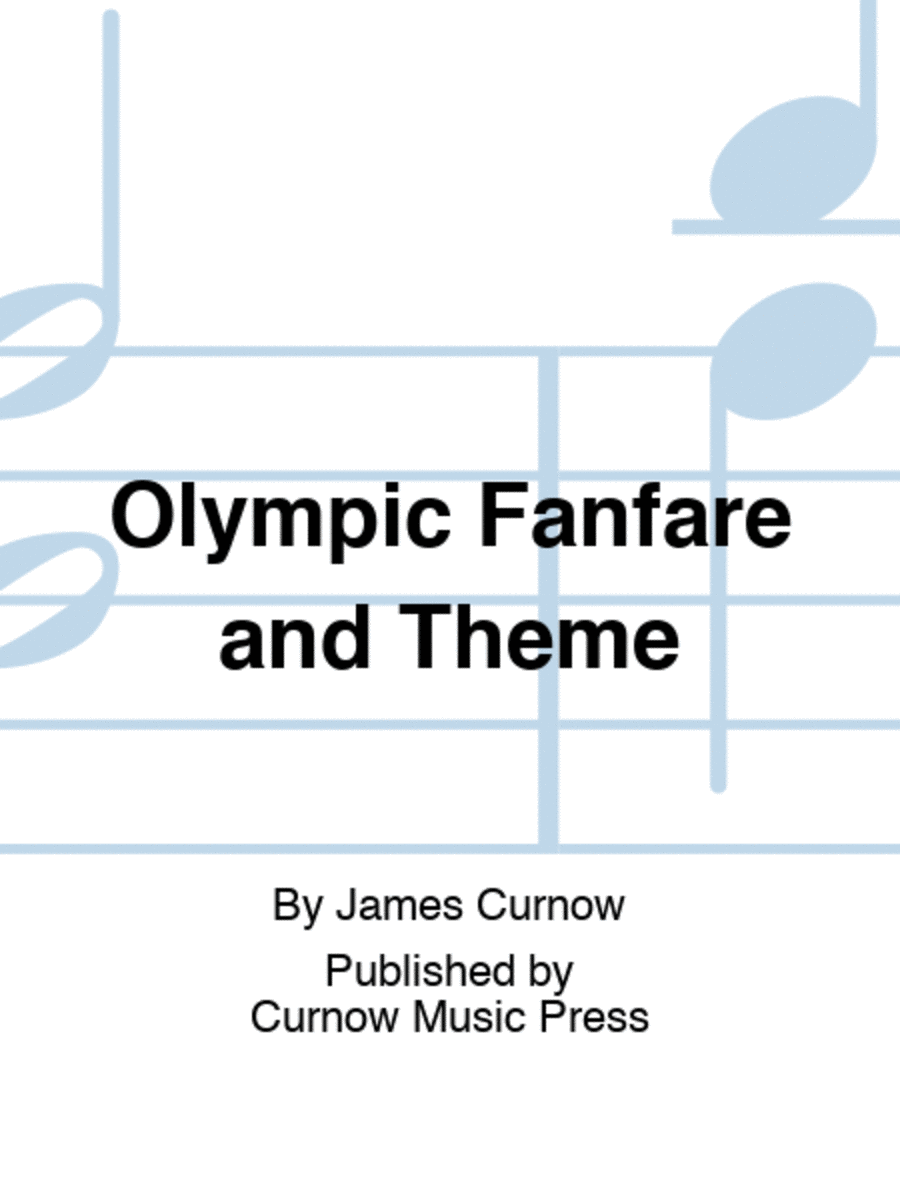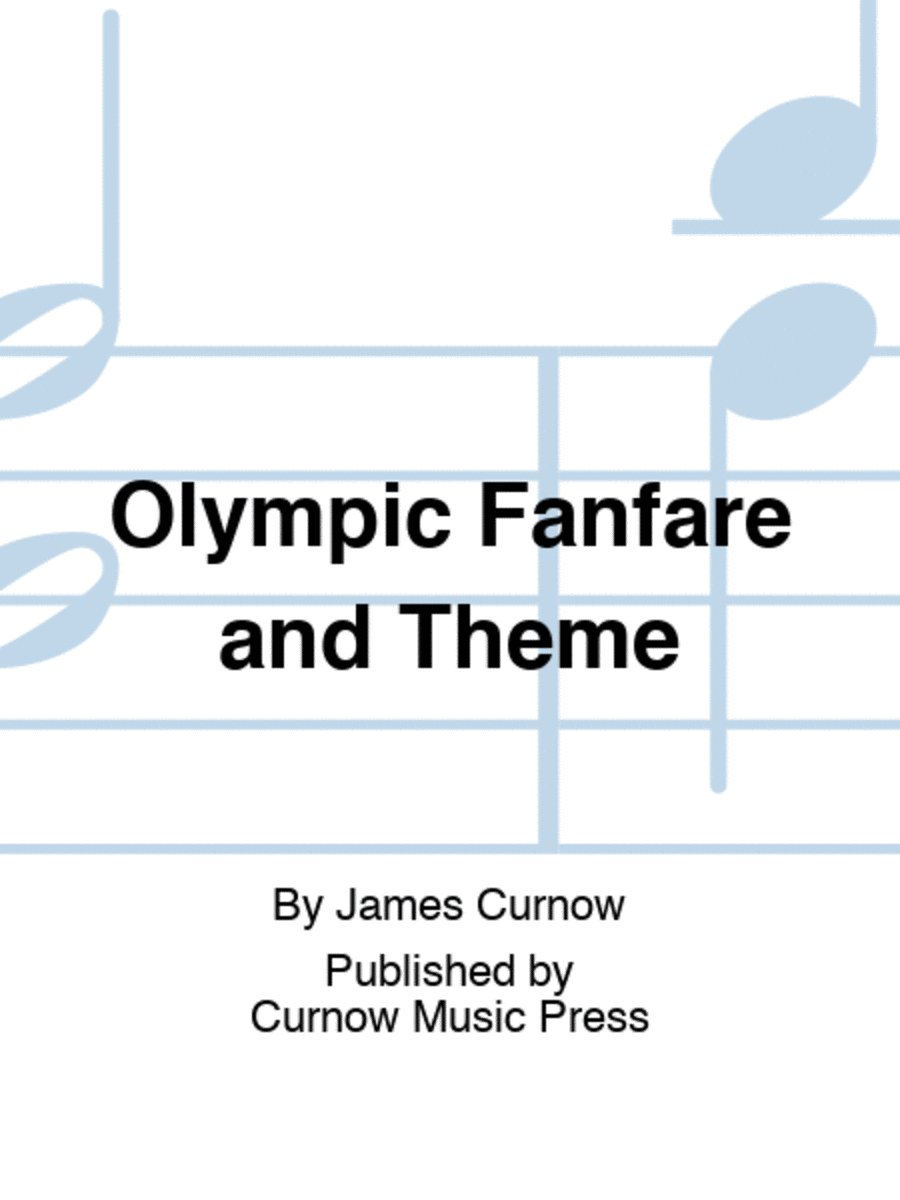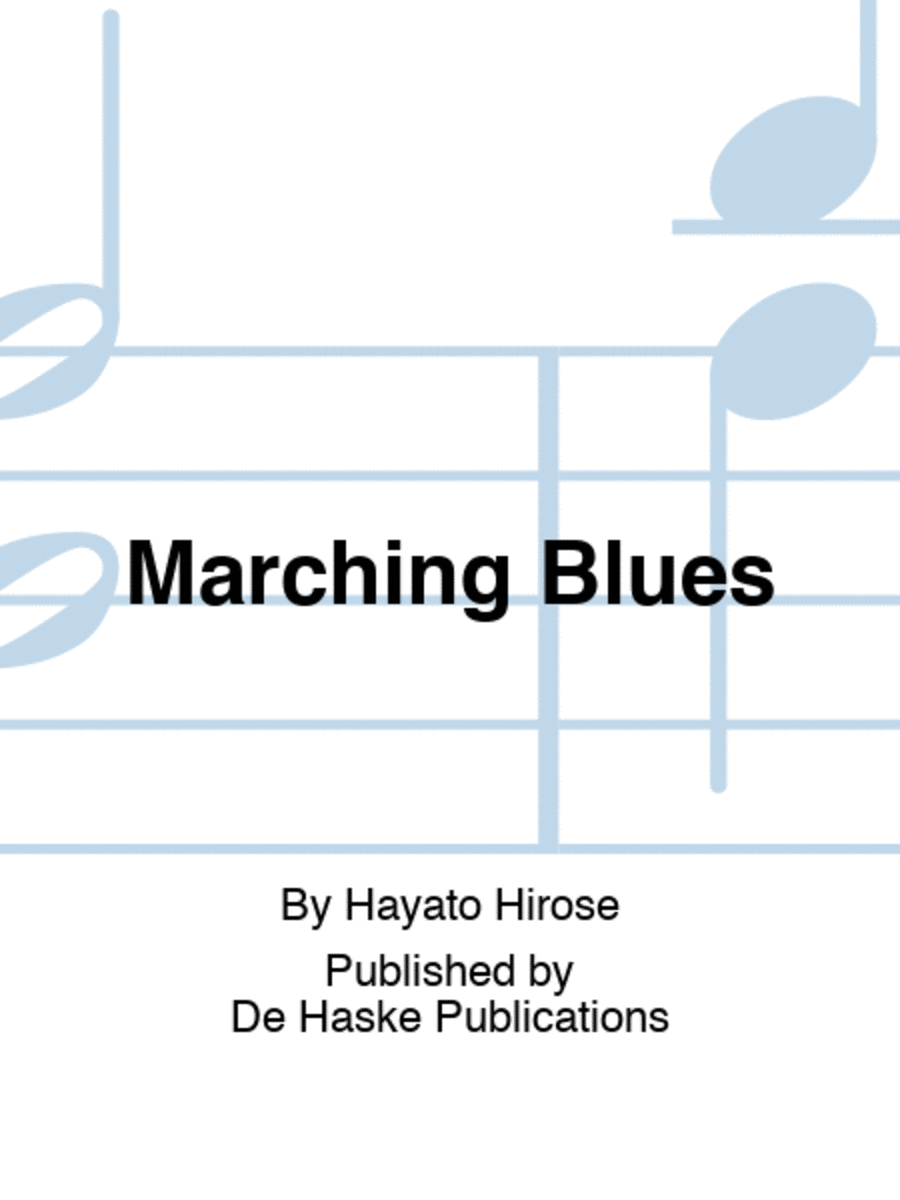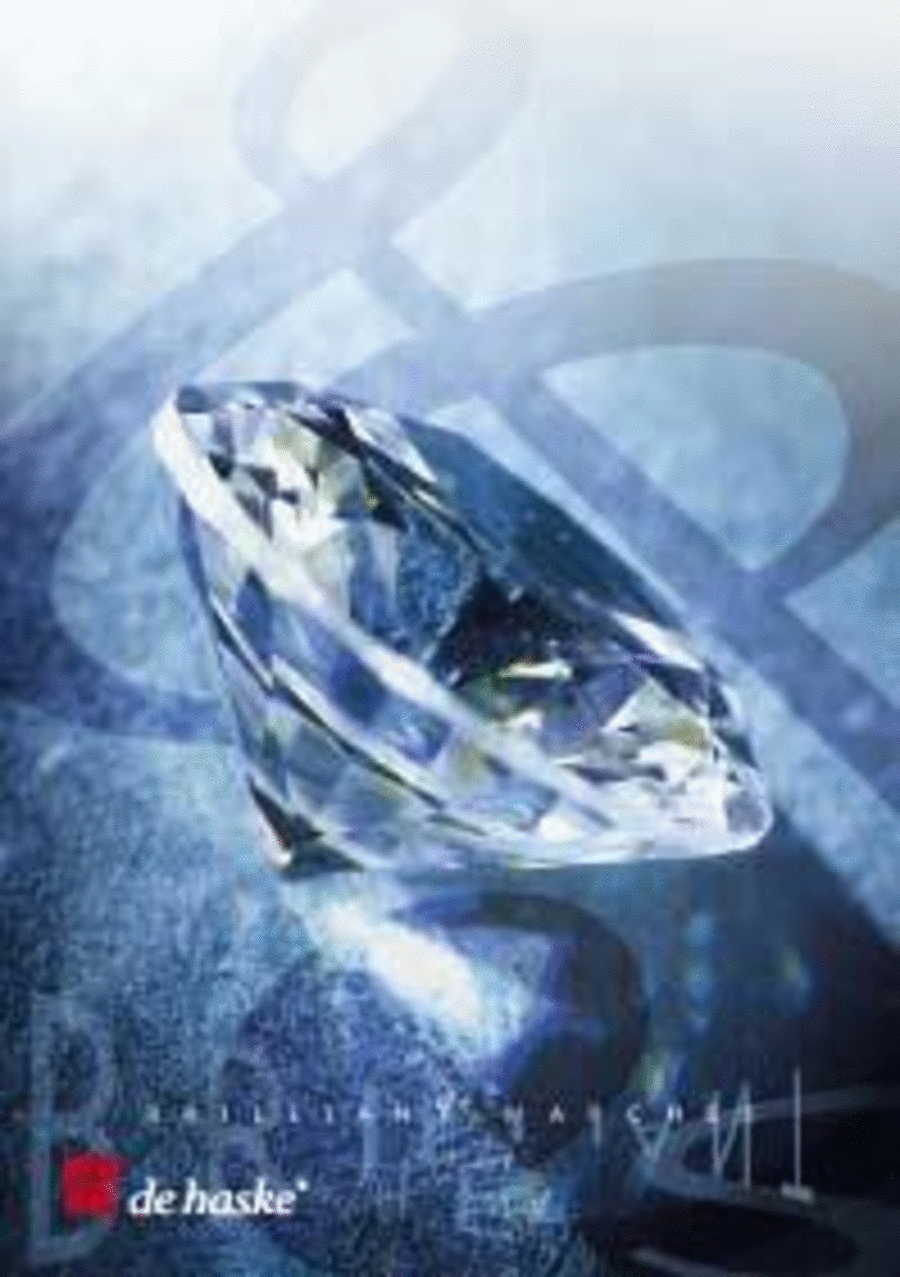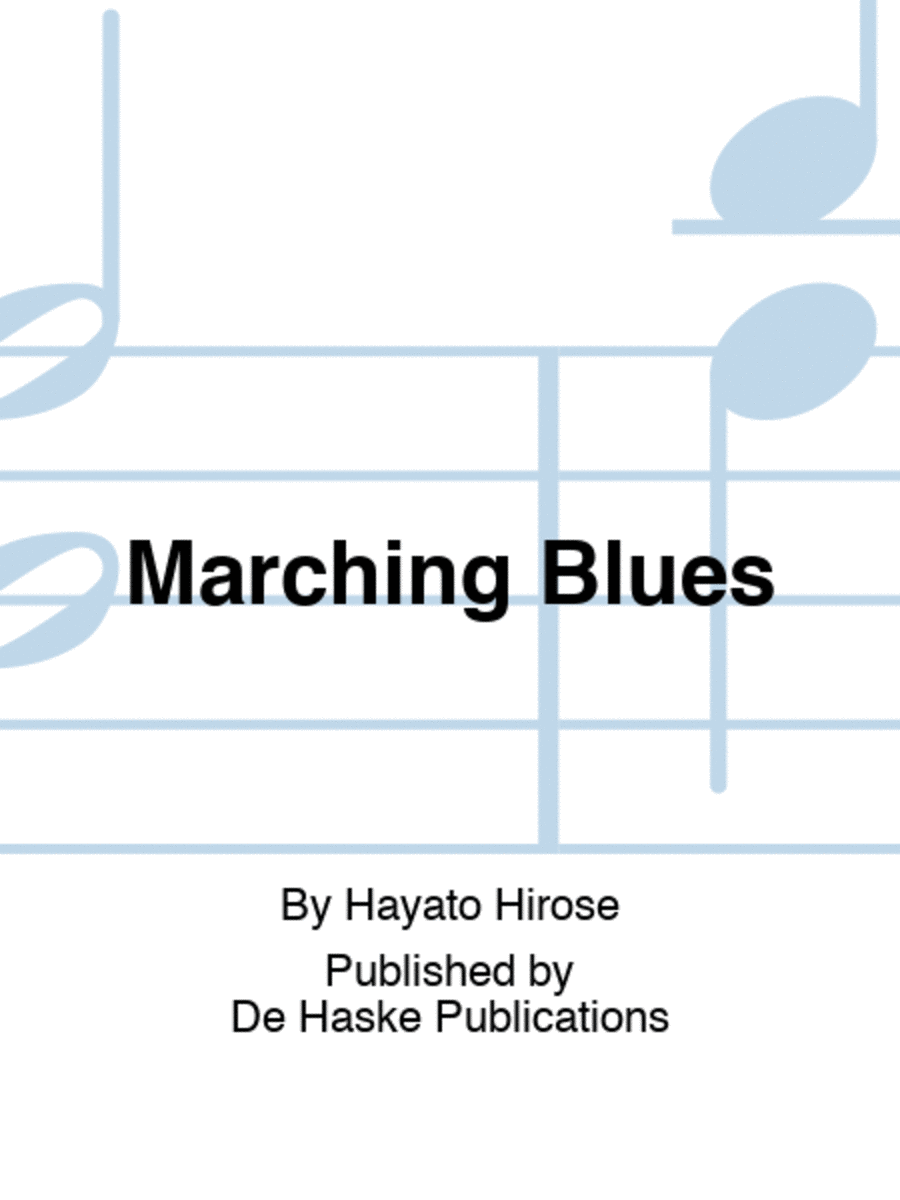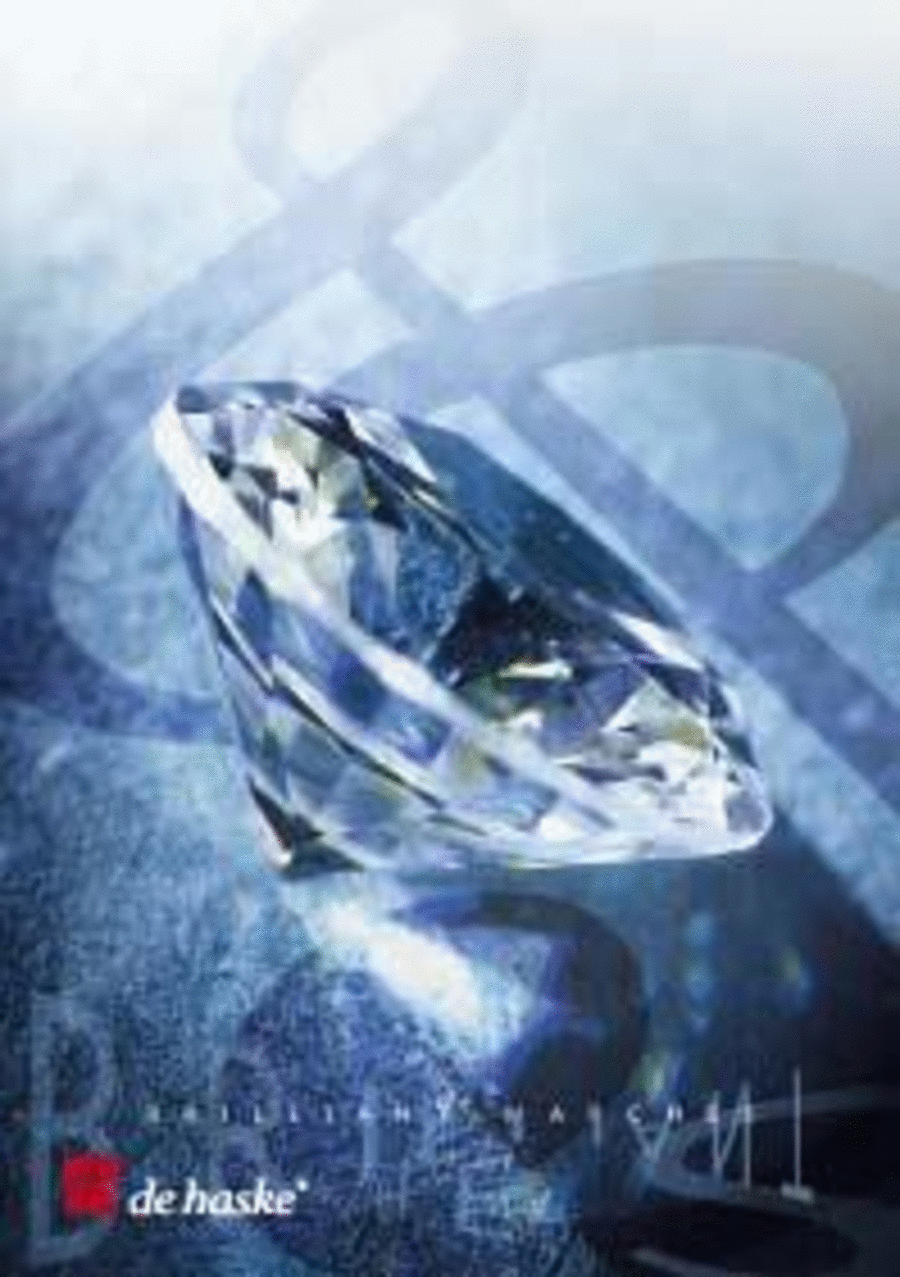|
| Jubilant Prelude
Fanfare [Conducteur] - Intermédiaire
Gobelin Music Publications
Fanfare Band - Grade 4 SKU: BT.GOB-000782-120 Arranged by Wim Rouw. Score...(+)
Fanfare Band - Grade 4
SKU:
BT.GOB-000782-120
Arranged by Wim Rouw.
Score Only. Gobelin Music
Publications #GOB
000782-120. Published by
Gobelin Music
Publications
(BT.GOB-000782-120).
‘Jubilant
Prelude’ is an
orchestration of the
‘Preludium over Psalm
150’ originally
composed for organ by
Toon Hagen. Since 1998
Toon Hagen has been
organ-player of the
‘Grote or Sint
Michaëlskerk’ in
Zwolle (the Netherlands).
He has written several
‘contemporary’
compositions for
organ.‘Jubilant
Prelude’ has a
capricious character by
the use of irregular
measures and its many
measure changes. The
structure of the Prelude
is that of a fugue and is
based on motives from the
psalm.After the first
climax, which is both
dynamic and harmonic, the
theme in the Andante
Jubiloso is clearly
audible and it is
alternated with erratic
motifs. Tension increases
until at last the psalm
itself isheard in all its
glory. The melody of the
psalm sounds as a cantus
firmus in tenor register,
with motifs in
ornamentation for
saxophones, bugles and
trumpets. The finale,
like the prelude is
capricious and
vehement.The
instrumentation for
fanfare band was made by
Wim Rouw. It is
particularly colourful
and has a surprising role
for the percussion
section.
‘Jubilant
Prelude’ is een
orkestbewerking van het
oorspronkelijk voor orgel
geschreven ‘Preludium
over Psalm 150’ van de
hand van Toon Hagen.
Sinds 1998 is Toon Hagen
als organist verbonden
aan de Grote of Sint
Michaëlskerk te
Zwolle.Hij heeft meerdere
‘eigentijdse’
composities voor orgel op
zijn naam
staan.‘Jubilant
Prelude’ krijgt door
het gebruik van
onregelmatige maatsoorten
en vele maatwisselingen
een grillig karakter.De
opbouw van de Prelude is
fugatisch,en is gebaseerd
op motieven van de
psalm.Na de eerste
climax, dynamisch en
harmonisch, is op het
Andante Jubiloso het
thema duidelijk hoorbaar,
en wordt afgewisseld met
grillige motieven. De
spanning neemt toe totdat
de psalmin volle glorie
volgt. De melodie van de
psalm klinkt als een
cantus firmus in het
tenor register, met een
omspeling in saxofoons,
bugels en trompetten.Het
slot is net als het
voorspel grillig en
heftig.De instrumentatie
voorfanfare orkest is van
Wim Rouw. Deze is
bijzonder kleurrijk met
een verrassend gebruik
van het slagwerk. $24.95 - Voir plus => AcheterDélais: 4 to 6 weeks | | | |
| Mirage
Fanfare [Conducteur et Parties séparées] - Facile
De Haske Publications
Fanfare Band - Grade 2.5 SKU: BT.DHP-1115006-020 March. Composed b...(+)
Fanfare Band - Grade 2.5
SKU:
BT.DHP-1115006-020
March. Composed by
Jacob De Haan. On Parade!
Set (Score & Parts).
Composed 2010. De Haske
Publications #DHP
1115006-020. Published by
De Haske Publications
(BT.DHP-1115006-020).
9x12 inches. A
mirage is an illusion,
something without
substance that does not
really exist. Although
not real, its
unattainable nature is
perfect for musical
inspiration. Composer
Jacob de Haan was
strolling through a
picturesque forest of the
Dutch Gelderland when he
thought he saw a body of
water. While there was no
water, its mere image
created waves that can be
relived in De
Haan’s original
composition, Mirage.
Mirage is
het Engelse synoniem voor
‘Fata
Morgana‘. De
creatieve aanleiding voor
deze compositie was dan
ook het verhaal van een
wandelaar die in een
boslandschap in
Gelderland water denkt te
zien. Het in het triodeel
deelsgezongen
‘wandelthema�
� brengt de vreugde die
de toeschouwer aan dit
natuurverschijnsel
beleeft bijzonder goed
tot
uitdrukking.
Mirag
e“ ist ein
englisches Synonym
für Fata
Morgana“. Als
kreativer Anstoß
für diese
Komposition diente Jacob
de Haan ein
Spaziergänger, der
durch eine Waldlandschaft
im holländischen
Gelderland geht und dabei
glaubt, ein Gewässer
zu sehen. Das im Trio
teilweise gesungene
Spaziergangs“-Thema
bringt die Freude an
diesem Naturerlebnis
besonders gut zum
Ausdruck.
«
Fata Morgana » est le
nom donné un
phénomène de
mirage, et que l'on
attribuait la fée
Morgane. Du mirage, nous
passons aux notes
joyeuses d’une
étrange promenade en
forêt où la
lumière donne la
sensation de
l’existence
d’une nappe
d’eau au pied
d’un arbre. Mirage
ou réalité ? vous
de le découvrir. Ce
qui est s r, c’est
que le Thème de la
promenade (Trio) est
partiellement chanté.
Una sorta di
miraggio ha ispirato
Jacob de Haan a comporre
questo brano, prendendo
spunto appunto da un
“miraggio†di
uno specchio
d’acqua che gli si
è presentato durante
una passeggiata in una
foresta in Olanda. Il
tema della
“passeggiataâ€
parzialmente cantato nel
trio, enfatizza gli
spettacoli che la natura
ci offre. $90.95 - Voir plus => AcheterDélais: 2 to 3 weeks | | | |
| Mirage
Fanfare - Facile
De Haske Publications
Fanfare Band - Grade 2.5 SKU: BT.DHP-1115006-120 March. Composed b...(+)
Fanfare Band - Grade 2.5
SKU:
BT.DHP-1115006-120
March. Composed by
Jacob De Haan. On Parade!
Score Only. Composed
2010. 16 pages. De Haske
Publications #DHP
1115006-120. Published by
De Haske Publications
(BT.DHP-1115006-120).
9x12 inches. A
mirage is an illusion,
something without
substance that does not
really exist. Although
not real, its
unattainable nature is
perfect for musical
inspiration. Composer
Jacob de Haan was
strolling through a
picturesque forest of the
Dutch Gelderland when he
thought he saw a body of
water. While there was no
water, its mere image
created waves that can be
relived in De
Haan’s original
composition, Mirage.
Mirage is
het Engelse synoniem voor
‘Fata
Morgana‘. De
creatieve aanleiding voor
deze compositie was dan
ook het verhaal van een
wandelaar die in een
boslandschap in
Gelderland water denkt te
zien. Het in het triodeel
deelsgezongen
‘wandelthema�
� brengt de vreugde die
de toeschouwer aan dit
natuurverschijnsel
beleeft bijzonder goed
tot
uitdrukking.
Mirag
e“ ist ein
englisches Synonym
für Fata
Morgana“. Als
kreativer Anstoß
für diese
Komposition diente Jacob
de Haan ein
Spaziergänger, der
durch eine Waldlandschaft
im holländischen
Gelderland geht und dabei
glaubt, ein Gewässer
zu sehen. Das im Trio
teilweise gesungene
Spaziergangs“-Thema
bringt die Freude an
diesem Naturerlebnis
besonders gut zum
Ausdruck.
«
Fata Morgana » est le
nom donné un
phénomène de
mirage, et que l'on
attribuait la fée
Morgane. Du mirage, nous
passons aux notes
joyeuses d’une
étrange promenade en
forêt où la
lumière donne la
sensation de
l’existence
d’une nappe
d’eau au pied
d’un arbre. Mirage
ou réalité ? vous
de le découvrir. Ce
qui est s r, c’est
que le Thème de la
promenade (Trio) est
partiellement chanté.
Una sorta di
miraggio ha ispirato
Jacob de Haan a comporre
questo brano, prendendo
spunto appunto da un
“miraggio†di
uno specchio
d’acqua che gli si
è presentato durante
una passeggiata in una
foresta in Olanda. Il
tema della
“passeggiataâ€
parzialmente cantato nel
trio, enfatizza gli
spettacoli che la natura
ci offre. $19.95 - Voir plus => AcheterDélais: 2 to 3 weeks | | | |
| Ostinati
Fanfare [Conducteur et Parties séparées] - Intermédiaire/avancé
De Haske Publications
Fanfare Band - Grade 6 SKU: BT.DHP-1115084-020 Composed by Jan Van der Ro...(+)
Fanfare Band - Grade 6
SKU:
BT.DHP-1115084-020
Composed by Jan Van der
Roost. Concert and
Contest Collection CBHA.
Set (Score & Parts). De
Haske Publications #DHP
1115084-020. Published by
De Haske Publications
(BT.DHP-1115084-020).
9x12 inches.
English-German-French-Dut
ch. It may be
surprising to see a
fanfare piece
commissioned by a
Japanese ensemble, since
fanfare orchestras are
typically found in
Belgium, Holland and
Luxembourg, and also
France and Switzerland.
Senzoku Gakuen is one of
the largest and
mostprestigious music
universities in Japan,
and home to a wide
variety of ensembles and
orchestras. Since 2006
they have had a fanfare
orchestra, which was
started by Sotaru
Fukaishi, a euphonium
teacher who felt further
performance opportunity
wasneeded for saxhorn
instruments. Fukaishi had
loved the sound of
fanfare orchestras ever
since visiting the World
Music Contest in Kerkrade
(Holland) several years
earlier. Jan Van der
Roost was involved with
this new initiative from
the beginning,and they
were also joined by Manu
Mellaerts for certain
projects. The Dean of the
music department,
Professor Kazuo Tomioka,
fully supports the
ensemble and commissioned
Ostinati. The
première took place on
June 11th at Maeda Hall
inMizonokuchi (Kawasaki)
where Senzoku Gakuen is
based. The piece opens
with an impressive
timpani solo, followed by
brass and saxophone. The
rhythmical pulse remains
constant and the music is
fiery and assertive in
character. A pentatonic
melodygradually emerges
and the music loses its
vehemency and softens.
The initial percussion
ostinati subsequently
recurs and the first
section of the piece
concludes in a similar
mood to the opening. The
second movement is sweet
and melodic, opening
witha long passage for
the saxophone family in a
minor key. The same theme
then appears in the major
and is developed upon;
the music builds to a
majestic orchestral
forte, reminiscent of a
pipe organ in its
sonority. The theme
returns in the
originalminor key with a
change in instrumentation
leading the movement to a
quiet and peaceful end on
a soft E minor chord. The
finale starts with
percussion: a four-bar
pattern is repeated
several times over which
the movement’s
melodic themes
areintroduced. These
melodic elements are
varied and used in
different versions and
the ostinato idea, which
characterizes the entire
piece, is highlighted.
The theme travels through
the orchestra, appearing
on various instruments
and in variousregisters.
It captures the
listener’s
attention and displays
the full range of sound
and colour within the
fanfare
orchestra.
Het is
misschien verrassend dat
dit fanfarewerk is
geschreven in opdracht
van een Japans ensemble,
aangezien fanfareorkesten
vooral te vinden zijn in
België, Nederland en
Luxemburg, en ook wel in
Frankrijk en Zwitserland.
SenzokuGakuen is een van
de grootste en meest
prestigieuze
muziekopleidingen van
Japan, en de thuisbasis
van een grote
verscheidenheid van
ensembles en orkesten. In
2006 is er een
fanfareorkest opgericht,
en wel door Sotaru
Fukaishi,
eeneuphoniumdocent die
vond dat er meer
mogelijkheden moesten
komen voor optredens met
saxhoorninstrumenten.
Fukaishi had enkele jaren
daarvoor genoten van de
fanfareklank toen hij het
Wereld Muziek Concours in
Kerkrade bezocht.
DeBelgische componist Jan
Van der Roost was van het
begin af aan betrokken
bij dit nieuwe
initiatief, en ook Manu
Mellaerts werd voor een
aantal projecten
aangetrokken. Het hoofd
van de muziekfaculteit,
professor Kazuo Tomioka,
staatgeheel achter het
ensemble en gaf de
opdracht tot het
schrijven van
Ostinati. De
première vond plaats
op 11 juni in de Maeda
Hall in Mizonokuchi
(Kawasaki), waar Senzoku
Gakuen is gevestigd. Het
werk begint met een
indrukwekkendepaukensolo,
gevolgd door koper en
saxofoon. De ritmische
puls blijft constant, en
de aard van de muziek is
vurig en krachtig.
Geleidelijk komt er een
pentatonische melodie
naar voren en wordt de
muziek minder heftig, ze
wordtzachter van
karakter. De
aanvankelijke ostinati in
het slagwerk verschijnen
dan opnieuw, waarna het
eerste deel van het werk
eindigt in dezelfde sfeer
als waarmee het begon.
Het tweede deel is
lieflijk en melodisch.
Het opentmet een lange
passage voor de saxofoons
in een mineurtoonsoort.
Dan klinkt hetzelfde
thema in majeur en daar
wordt op voortgeborduurd:
de muziek ontwikkelt zich
tot een majestueus
orkestraal forte, dat qua
sonoriteit doet
denken
Es mag
überraschen, dass
dieses
Fanfareorchesterwerk
ausgerechnet von einem
japanischen Ensemble in
Auftrag gegeben wurde, da
Fanfareorchester doch
eher in Belgien, den
Niederlanden oder
Luxemburg oder auch in
Frankreich oder Schweiz
zu finden sind. Senzoku
Gakuen ist eine der
größten und
renommiertesten
Musikschulen Japans und
Heimstätte einer
Vielfalt an Ensembles und
Orchestern. Im Jahr 2006
wurde ein
Fanfareorchester
gegründet. Den
Anstoß gab Sotaru
Fukaishi, ein
Euphoniumlehrer, der den
Instrumenten der
Saxhorn-Familie mehr
Spielmöglichkeiten
bieten wollte. Fukaishi
hatte sich einige Jahre
zuvor bei der
Weltmeisterschaft in
Kerkrade (Holland) in den
Klang
vonFanfareorchestern
verliebt. Jan Van der
Roost war von Beginn an
in die Entwicklung dieser
Idee involviert und,
einige Projekte
betreffend, ebenso Manu
Mellaerts. Der Dekan des
Musik-Colleges, Professor
Kazuo Tomioka, steht voll
und ganz hinter dem
Ensemble und gab
Ostinati in
Auftrag. Die Premiere
fand am 11. Juni 2011 in
der Maeda Hall in
Mizonokuchi statt, dem
Heimatort der Schule
Senzoku Gakuen. Das
Stück beginnt mit
einem eindrucksvollen
Paukensolo, bevor
Blechbläser und
Saxophon einsetzen. Der
rhythmische Puls bleibt
konstant unter einer
feurigen,
nachdrücklichen Musik.
Eine pentatonische
Melodie bildet sich nach
und nach heraus,
während die Musik an
Heftigkeit verliert und
sanfter wird. Die
anfänglichen Ostinati
im Schlagwerk kehren
zurück und so endet
der erste Satz des Werkes
in einer der Eröffnung
ähnlichen Stimmung.
Der zweite Satz ist
lieblich und melodiös.
Er beginnt mit einem
langen Abschnitt für
die Saxophone in Moll.
Dann erscheint das
gleiche Thema in Dur und
durchläuft eine
Entwicklung; die Musik
baut sich zu einem
majestätischen
orchestralen Forte auf,
das in seiner
Klangfülle an eine
Orgel erinnert. Dann
kehrt das Thema in seiner
ursprünglichen
Moll-Tonart und in
veränderter
Instrumentierung
zurück, um den Satz
ruhig und friedvoll in
einem e-Moll-Akkord enden
zu lassen.
Il
pourrait paraître
surprenant qu’un
ensemble japonais puisse
commander une pièce
pour orchestre de
fanfare, puisque
l’on rencontre
surtout ce type de
formation en Belgique,
aux Pays-Bas et au
Luxembourg, ainsi
qu’en France et en
Suisse. Senzoku Gakuen,
l’une des plus
grandes et plus
prestigieuses
académies de musique
du Japon, compte une
grande variété
d’ensembles et
d’orchestres. En
2006 s’y est
ajouté un orchestre de
fanfare fondé par
Sotaru Fukaishi, un
professeur
d’euphonium qui
pensait qu’il
était nécessaire
d’offrir de plus
larges possibilités
aux cuivres de la
région. Depuis
qu’il avait
assisté au World Music
Contest de Kerkrade
(Pays-Bas), plusieurs
années
auparavant,Fukaishi se
prit de passion pour le
son chaud et
généreux de
l’orchestre de
fanfare, une formation
atypique au Japon. Jan
Van der Roost a
favorablement
adhéré cette
nouvelle initiative,
tandis que Manu Mellaerts
collabora avec les deux
hommes afin de
concrétiser certains
projets. Le professeur
Kazuo Tomioka, doyen du
collège de musique,
soutint vigoureusement
l’orchestre et
commanda Ostinati.
La création de
l’oeuvre fut
donnée le 11 juin 2011
au Maeda Hall de
Mizonokuchi (Kawasaki),
où se trouve Senzoku
Gakuen. La pièce
débute avec un
impressionnant solo de
timbales précédant
l’entrée des
cuivres et des
saxophones. La pulsion
rythmique est constante,
la musique est
énergique et de
caractère affirmé.
Une mélodie
pentatonique émerge
graduellement, alors que
la trame musicale diminue
d’intensité et
s’adoucit.
L’ostinato la
percussion revient
fréquemment et la
première partie de
l’oeuvre se
termine dans un climat
semblable celui du
début. Le deuxième
mouvement, doux et
romancé, débute
avec un long passage en
mode mineur joué par
les saxophones. Le
même thème
apparaît alors en mode
majeur et se développe
peu peu ; la musique
s’intensifie pour
arriver un majestueux et
orchestral forte dont les
sonorités rappellent
celles d’un orgue
d’église. Puis
le thème revient sa
tonalité mineure
d’origine avec un
changement
d’instrumentation
qui mène. $478.95 - Voir plus => AcheterDélais: 2 to 3 weeks | | | |
| Ostinati
Fanfare [Conducteur] - Intermédiaire/avancé
De Haske Publications
Fanfare Band - Grade 6 SKU: BT.DHP-1115084-120 Composed by Jan Van der Ro...(+)
Fanfare Band - Grade 6
SKU:
BT.DHP-1115084-120
Composed by Jan Van der
Roost. Concert and
Contest Collection CBHA.
Score Only. Composed
2012. 99 pages. De Haske
Publications #DHP
1115084-120. Published by
De Haske Publications
(BT.DHP-1115084-120).
9x12 inches.
English-German-French-Dut
ch. It may be
surprising to see a
fanfare piece
commissioned by a
Japanese ensemble, since
fanfare orchestras are
typically found in
Belgium, Holland and
Luxembourg, and also
France and Switzerland.
Senzoku Gakuen is one of
the largest and
mostprestigious music
universities in Japan,
and home to a wide
variety of ensembles and
orchestras. Since 2006
they have had a fanfare
orchestra, which was
started by Sotaru
Fukaishi, a euphonium
teacher who felt further
performance opportunity
wasneeded for saxhorn
instruments. Fukaishi had
loved the sound of
fanfare orchestras ever
since visiting the World
Music Contest in Kerkrade
(Holland) several years
earlier. Jan Van der
Roost was involved with
this new initiative from
the beginning,and they
were also joined by Manu
Mellaerts for certain
projects. The Dean of the
music department,
Professor Kazuo Tomioka,
fully supports the
ensemble and commissioned
Ostinati. The
première took place on
June 11th at Maeda Hall
inMizonokuchi (Kawasaki)
where Senzoku Gakuen is
based. The piece opens
with an impressive
timpani solo, followed by
brass and saxophone. The
rhythmical pulse remains
constant and the music is
fiery and assertive in
character. A pentatonic
melodygradually emerges
and the music loses its
vehemency and softens.
The initial percussion
ostinati subsequently
recurs and the first
section of the piece
concludes in a similar
mood to the opening. The
second movement is sweet
and melodic, opening
witha long passage for
the saxophone family in a
minor key. The same theme
then appears in the major
and is developed upon;
the music builds to a
majestic orchestral
forte, reminiscent of a
pipe organ in its
sonority. The theme
returns in the
originalminor key with a
change in instrumentation
leading the movement to a
quiet and peaceful end on
a soft E minor chord. The
finale starts with
percussion: a four-bar
pattern is repeated
several times over which
the movement’s
melodic themes
areintroduced. These
melodic elements are
varied and used in
different versions and
the ostinato idea, which
characterizes the entire
piece, is highlighted.
The theme travels through
the orchestra, appearing
on various instruments
and in variousregisters.
It captures the
listener’s
attention and displays
the full range of sound
and colour within the
fanfare
orchestra.
Het is
misschien verrassend dat
dit fanfarewerk is
geschreven in opdracht
van een Japans ensemble,
aangezien fanfareorkesten
vooral te vinden zijn in
België, Nederland en
Luxemburg, en ook wel in
Frankrijk en Zwitserland.
SenzokuGakuen is een van
de grootste en meest
prestigieuze
muziekopleidingen van
Japan, en de thuisbasis
van een grote
verscheidenheid van
ensembles en orkesten. In
2006 is er een
fanfareorkest opgericht,
en wel door Sotaru
Fukaishi,
eeneuphoniumdocent die
vond dat er meer
mogelijkheden moesten
komen voor optredens met
saxhoorninstrumenten.
Fukaishi had enkele jaren
daarvoor genoten van de
fanfareklank toen hij het
Wereld Muziek Concours in
Kerkrade bezocht.
DeBelgische componist Jan
Van der Roost was van het
begin af aan betrokken
bij dit nieuwe
initiatief, en ook Manu
Mellaerts werd voor een
aantal projecten
aangetrokken. Het hoofd
van de muziekfaculteit,
professor Kazuo Tomioka,
staatgeheel achter het
ensemble en gaf de
opdracht tot het
schrijven van
Ostinati. De
première vond plaats
op 11 juni in de Maeda
Hall in Mizonokuchi
(Kawasaki), waar Senzoku
Gakuen is gevestigd. Het
werk begint met een
indrukwekkendepaukensolo,
gevolgd door koper en
saxofoon. De ritmische
puls blijft constant, en
de aard van de muziek is
vurig en krachtig.
Geleidelijk komt er een
pentatonische melodie
naar voren en wordt de
muziek minder heftig, ze
wordtzachter van
karakter. De
aanvankelijke ostinati in
het slagwerk verschijnen
dan opnieuw, waarna het
eerste deel van het werk
eindigt in dezelfde sfeer
als waarmee het begon.
Het tweede deel is
lieflijk en melodisch.
Het opentmet een lange
passage voor de saxofoons
in een mineurtoonsoort.
Dan klinkt hetzelfde
thema in majeur en daar
wordt op voortgeborduurd:
de muziek ontwikkelt zich
tot een majestueus
orkestraal forte, dat qua
sonoriteit doet
denken
Es mag
überraschen, dass
dieses
Fanfareorchesterwerk
ausgerechnet von einem
japanischen Ensemble in
Auftrag gegeben wurde, da
Fanfareorchester doch
eher in Belgien, den
Niederlanden oder
Luxemburg oder auch in
Frankreich oder Schweiz
zu finden sind. Senzoku
Gakuen ist eine der
größten und
renommiertesten
Musikschulen Japans und
Heimstätte einer
Vielfalt an Ensembles und
Orchestern. Im Jahr 2006
wurde ein
Fanfareorchester
gegründet. Den
Anstoß gab Sotaru
Fukaishi, ein
Euphoniumlehrer, der den
Instrumenten der
Saxhorn-Familie mehr
Spielmöglichkeiten
bieten wollte. Fukaishi
hatte sich einige Jahre
zuvor bei der
Weltmeisterschaft in
Kerkrade (Holland) in den
Klang
vonFanfareorchestern
verliebt. Jan Van der
Roost war von Beginn an
in die Entwicklung dieser
Idee involviert und,
einige Projekte
betreffend, ebenso Manu
Mellaerts. Der Dekan des
Musik-Colleges, Professor
Kazuo Tomioka, steht voll
und ganz hinter dem
Ensemble und gab
Ostinati in
Auftrag. Die Premiere
fand am 11. Juni 2011 in
der Maeda Hall in
Mizonokuchi statt, dem
Heimatort der Schule
Senzoku Gakuen. Das
Stück beginnt mit
einem eindrucksvollen
Paukensolo, bevor
Blechbläser und
Saxophon einsetzen. Der
rhythmische Puls bleibt
konstant unter einer
feurigen,
nachdrücklichen Musik.
Eine pentatonische
Melodie bildet sich nach
und nach heraus,
während die Musik an
Heftigkeit verliert und
sanfter wird. Die
anfänglichen Ostinati
im Schlagwerk kehren
zurück und so endet
der erste Satz des Werkes
in einer der Eröffnung
ähnlichen Stimmung.
Der zweite Satz ist
lieblich und melodiös.
Er beginnt mit einem
langen Abschnitt für
die Saxophone in Moll.
Dann erscheint das
gleiche Thema in Dur und
durchläuft eine
Entwicklung; die Musik
baut sich zu einem
majestätischen
orchestralen Forte auf,
das in seiner
Klangfülle an eine
Orgel erinnert. Dann
kehrt das Thema in seiner
ursprünglichen
Moll-Tonart und in
veränderter
Instrumentierung
zurück, um den Satz
ruhig und friedvoll in
einem e-Moll-Akkord enden
zu lassen.
Il
pourrait paraître
surprenant qu’un
ensemble japonais puisse
commander une pièce
pour orchestre de
fanfare, puisque
l’on rencontre
surtout ce type de
formation en Belgique,
aux Pays-Bas et au
Luxembourg, ainsi
qu’en France et en
Suisse. Senzoku Gakuen,
l’une des plus
grandes et plus
prestigieuses
académies de musique
du Japon, compte une
grande variété
d’ensembles et
d’orchestres. En
2006 s’y est
ajouté un orchestre de
fanfare fondé par
Sotaru Fukaishi, un
professeur
d’euphonium qui
pensait qu’il
était nécessaire
d’offrir de plus
larges possibilités
aux cuivres de la
région. Depuis
qu’il avait
assisté au World Music
Contest de Kerkrade
(Pays-Bas), plusieurs
années
auparavant,Fukaishi se
prit de passion pour le
son chaud et
généreux de
l’orchestre de
fanfare, une formation
atypique au Japon. Jan
Van der Roost a
favorablement
adhéré cette
nouvelle initiative,
tandis que Manu Mellaerts
collabora avec les deux
hommes afin de
concrétiser certains
projets. Le professeur
Kazuo Tomioka, doyen du
collège de musique,
soutint vigoureusement
l’orchestre et
commanda Ostinati.
La création de
l’oeuvre fut
donnée le 11 juin 2011
au Maeda Hall de
Mizonokuchi (Kawasaki),
où se trouve Senzoku
Gakuen. La pièce
débute avec un
impressionnant solo de
timbales précédant
l’entrée des
cuivres et des
saxophones. La pulsion
rythmique est constante,
la musique est
énergique et de
caractère affirmé.
Une mélodie
pentatonique émerge
graduellement, alors que
la trame musicale diminue
d’intensité et
s’adoucit.
L’ostinato la
percussion revient
fréquemment et la
première partie de
l’oeuvre se
termine dans un climat
semblable celui du
début. Le deuxième
mouvement, doux et
romancé, débute
avec un long passage en
mode mineur joué par
les saxophones. Le
même thème
apparaît alors en mode
majeur et se développe
peu peu ; la musique
s’intensifie pour
arriver un majestueux et
orchestral forte dont les
sonorités rappellent
celles d’un orgue
d’église. Puis
le thème revient sa
tonalité mineure
d’origine avec un
changement
d’instrumentation
qui mène. $115.95 - Voir plus => AcheterDélais: 2 to 3 weeks | | | |
| Olympic Fanfare and Theme
Fanfare - Intermédiaire
Curnow Music
Fanfare Band - Grade 4 SKU: BT.CMP-0108-96-020 Composed by James Curnow. ...(+)
Fanfare Band - Grade 4
SKU:
BT.CMP-0108-96-020
Composed by James Curnow.
Prestige Series. Opening
Pieces. Set (Score and
Parts). Composed 1996.
Curnow Music #CMP
0108-96-020. Published by
Curnow Music
(BT.CMP-0108-96-020).
Dramatic
trumpet fanfares announce
a flowing main
theme,creating an
atmosphere of
exhilaration and
anticipation.Commissioned
for the 1996 Atlanta
Centennial
Olympics,Olympic Fanfare
and Theme will make a
brilliant opener forany
occasion
Dit
werk, dat door de Olympic
Band wordt gespeeld als
de olympische vlag wordt
gehesen, bevat virtuoze
fanfares in het koper,
afgewisseld met de
percussie en de
spectaculaire klanken van
de houtblazers. Het
dramatisch vloeiende
hoofdthemawordt van tijd
tot tijd onderbroken door
motieven uit de
openingsfanfare. Een
contrasterend middendeel
met een hoofdrol voor het
lage koper gaat vooraf
aan een herhaling van de
openingsfanfare en een
laatste presentatie
vanhet
hoofdthema.
Dramat
ische Trompetenklänge
kündigen hier ein
flieÃ?endes Hauptthema
an und schaffen eine
Atmosphäre der
Vorfreude und des
Hochgefühls.
Olympic Fanfare and
Theme, das für die
Olympischen Spiele 1996
in Atlanta in Auftrag
gegeben wurde, ist ein
ideales
Eröffnungsstück
für jeden Anlass.
partir de 776
avant J.-C. et pendant
plus dâ??un
millénaire, les Jeux
Olympiques antiques ont
eu lieu dans le site
sacré dâ??Olympie en
Grèce. Lâ??année
1896 voit la renaissance
de lâ??olympisme. Le
baron Pierre de Coubertin
organise les premiers
Jeux modernes Athènes.
En 1996, Atlanta
célèbre avec faste
le centenaire des Jeux.
James Curnow compose la
demande du Comité
Olympique dâ??Atlanta
cette ?uvre brillante,
idéale pour débuter
un concert. $104.95 - Voir plus => AcheterDélais: 2 to 3 weeks | | | |
| The Fever Tree
Fanfare [Conducteur et Parties séparées] - Facile
Gobelin Music Publications
Fanfare Band - Grade 3 SKU: BT.GOB-001010-020 Composed by Rob Goorhuis. S...(+)
Fanfare Band - Grade 3
SKU:
BT.GOB-001010-020
Composed by Rob Goorhuis.
Set (Score & Parts). 144
pages. Gobelin Music
Publications #GOB
001010-020. Published by
Gobelin Music
Publications
(BT.GOB-001010-020).
The composition
".The Fever
Tree". in 2008 was
commissioned by the Music
Association of Central
and Eastern Netherlands
St.Willibrord as a gift
to all its members on the
occasion of the formation
of a national music
organization and the
elimination of the music
union for Central and
Eastern Netherlands
St.Willibrord.
The
fever tree is a
controversial legend
about St. Willibrord
(658-739).
The
daughter of a pagan
chieftain of Hoemannen
that made the area around
Heumen unsafe, was
seriously ill. They
feared for her life.
The chief of the gang
turned to predatory
Willibrord, who same time
in this region led
mission.
Willibrord
commanded theman to
repent and a headband of
the girl
to a certain
special tree to hang.
The desperate captain
obeyed, and his daughter
was a miraculous heal.
Then came the anger
of the Hoemannen against
their leader, who in
their
eyes had
committed treason by the
group to convert. They
abused themselves to him
and killed him brutally.
The daughter remained
behind in great sorrow,
comforted by Willibrord.
The composition
has the following scenes:
- Andante moderato -
the calling of Willibrord
- Allegro moderato -
Willibrord passes through
the province of Brabant
and try to people to
repent
- Vivace -
Hoemannen terrorize the
inhabitants of the area
Heumen
- Andante -
the healing of the sick
girl and the conversion
of the centurion
-
Inquieto - the revenge of
the Hoemannen
-
Adagio - elegy on the
death of the chief
De compositie
'The Fever Tree' (De
koortsboom) werd in 2008
geschreven in opdracht
van de Muziekbond Midden-
en Oost Nederland
St.Willibrord, als
geschenk aan al haar
leden bij gelegenheid van
de vorming van één
landelijke
muziekorganisatieen de
opheffing van de
muziekbond voor Midden-
en Oost Nederland
St.Willibrord.
De
koortsboom is een
omstreden legende rond
St. Willibrord
(658-739).
De dochter
van de heidense hoofdman
van de Hoemannen, diehet
gebied rond Heumen
onveilig maakten, was
ernstig ziek. Men vreesde
voor haar leven. De
hoofdman van de
roofzuchtige bende wende
zich tot Willibrord, die
in dezelfde tijd in deze
streek missioneerde.
Willibrord gebood deman
zich te bekeren én een
hoofdband van het meisje
aan een bepaalde,
bijzondere boom te
hangen. De radeloze
hoofdman gehoorzaamde en
zijn dochter werd op
wonderbaarlijke wijze
genezen. Toen keerde de
woede van de Hoemannen
zichtegen hun leider, die
in hun ogen verraad had
gepleegd aan de groep
door zich te bekeren. Ze
vergrepen zich aan hem en
vermoordden hem op
gruwelijke wijze. De
dochter bleef in grote
droefheid achter,
getroost door
Willibrord.
De
compositie kent de
volgende
tableaus:
-
Andante moderato - de
roeping van Willibrord
- Allegro moderato -
Willibrord trekt door het
Brabantse land en tracht
de bevolking te bekeren
- Vivace -
deHoemannen terroriseren
de inwoners van het
gebied rond Heumen
-
Andante - de genezing van
het zieke meisje en de
bekering van de hoofdman
- Inquieto - de
wraak van de Hoemannen
- Adagio - treurzang
over de doodvan de
hoofdman. $203.95 - Voir plus => AcheterDélais: 2 to 3 weeks | | | |
| The Fever Tree
Fanfare [Conducteur] - Facile
Gobelin Music Publications
Fanfare Band - Grade 3 SKU: BT.GOB-001010-120 Composed by Rob Goorhuis. S...(+)
Fanfare Band - Grade 3
SKU:
BT.GOB-001010-120
Composed by Rob Goorhuis.
Score Only. 24 pages.
Gobelin Music
Publications #GOB
001010-120. Published by
Gobelin Music
Publications
(BT.GOB-001010-120).
The composition
".The Fever
Tree". in 2008 was
commissioned by the Music
Association of Central
and Eastern Netherlands
St.Willibrord as a gift
to all its members on the
occasion of the formation
of a national music
organization and the
elimination of the music
union for Central and
Eastern Netherlands
St.Willibrord.
The
fever tree is a
controversial legend
about St. Willibrord
(658-739).
The
daughter of a pagan
chieftain of Hoemannen
that made the area around
Heumen unsafe, was
seriously ill. They
feared for her life.
The chief of the gang
turned to predatory
Willibrord, who same time
in this region led
mission.
Willibrord
commanded theman to
repent and a headband of
the girl
to a certain
special tree to hang.
The desperate captain
obeyed, and his daughter
was a miraculous heal.
Then came the anger
of the Hoemannen against
their leader, who in
their
eyes had
committed treason by the
group to convert. They
abused themselves to him
and killed him brutally.
The daughter remained
behind in great sorrow,
comforted by Willibrord.
The composition
has the following scenes:
- Andante moderato -
the calling of Willibrord
- Allegro moderato -
Willibrord passes through
the province of Brabant
and try to people to
repent
- Vivace -
Hoemannen terrorize the
inhabitants of the area
Heumen
- Andante -
the healing of the sick
girl and the conversion
of the centurion
-
Inquieto - the revenge of
the Hoemannen
-
Adagio - elegy on the
death of the chief
De compositie
'The Fever Tree' (De
koortsboom) werd in 2008
geschreven in opdracht
van de Muziekbond Midden-
en Oost Nederland
St.Willibrord, als
geschenk aan al haar
leden bij gelegenheid van
de vorming van één
landelijke
muziekorganisatieen de
opheffing van de
muziekbond voor Midden-
en Oost Nederland
St.Willibrord.
De
koortsboom is een
omstreden legende rond
St. Willibrord
(658-739).
De dochter
van de heidense hoofdman
van de Hoemannen, diehet
gebied rond Heumen
onveilig maakten, was
ernstig ziek. Men vreesde
voor haar leven. De
hoofdman van de
roofzuchtige bende wende
zich tot Willibrord, die
in dezelfde tijd in deze
streek missioneerde.
Willibrord gebood deman
zich te bekeren én een
hoofdband van het meisje
aan een bepaalde,
bijzondere boom te
hangen. De radeloze
hoofdman gehoorzaamde en
zijn dochter werd op
wonderbaarlijke wijze
genezen. Toen keerde de
woede van de Hoemannen
zichtegen hun leider, die
in hun ogen verraad had
gepleegd aan de groep
door zich te bekeren. Ze
vergrepen zich aan hem en
vermoordden hem op
gruwelijke wijze. De
dochter bleef in grote
droefheid achter,
getroost door
Willibrord.
De
compositie kent de
volgende
tableaus:
-
Andante moderato - de
roeping van Willibrord
- Allegro moderato -
Willibrord trekt door het
Brabantse land en tracht
de bevolking te bekeren
- Vivace -
deHoemannen terroriseren
de inwoners van het
gebied rond Heumen
-
Andante - de genezing van
het zieke meisje en de
bekering van de hoofdman
- Inquieto - de
wraak van de Hoemannen
- Adagio - treurzang
over de doodvan de
hoofdman. $38.95 - Voir plus => AcheterDélais: 2 to 3 weeks | | | |
| Olympic Fanfare and Theme
Fanfare [Conducteur] - Intermédiaire
Curnow Music
Fanfare Band - Grade 4 SKU: BT.CMP-0108-96-120 Composed by James Curnow. ...(+)
Fanfare Band - Grade 4
SKU:
BT.CMP-0108-96-120
Composed by James Curnow.
Prestige Series. Opening
Pieces. Score Only.
Composed 1996. Curnow
Music #CMP 0108-96-120.
Published by Curnow Music
(BT.CMP-0108-96-120).
Dit werk, dat
door de Olympic Band
wordt gespeeld als de
olympische vlag wordt
gehesen, bevat virtuoze
fanfares in het koper,
afgewisseld met de
percussie en de
spectaculaire klanken van
de houtblazers. Het
dramatisch vloeiende
hoofdthemawordt van tijd
tot tijd onderbroken door
motieven uit de
openingsfanfare. Een
contrasterend middendeel
met een hoofdrol voor het
lage koper gaat vooraf
aan een herhaling van de
openingsfanfare en een
laatste presentatie
vanhet
hoofdthema.
Dramat
ische Trompetenklänge
kündigen hier ein
fließendes Hauptthema
an und schaffen eine
Atmosphäre der
Vorfreude und des
Hochgefühls.
Olympic Fanfare and
Theme, das für die
Olympischen Spiele 1996
in Atlanta in Auftrag
gegeben wurde, ist ein
ideales
Eröffnungsstück
für jeden Anlass.
partir de 776
avant J.-C. et pendant
plus d’un
millénaire, les Jeux
Olympiques antiques ont
eu lieu dans le site
sacré d’Olympie
en Grèce.
L’année 1896
voit la renaissance de
l’olympisme. Le
baron Pierre de Coubertin
organise les premiers
Jeux modernes Athènes.
En 1996, Atlanta
célèbre avec faste
le centenaire des Jeux.
James Curnow compose la
demande du Comité
Olympique
d’Atlanta cette
œuvre brillante,
idéale pour débuter
un concert. $18.95 - Voir plus => AcheterDélais: 2 to 3 weeks | | | |
| Marching Blues
Fanfare [Conducteur et Parties séparées] - Facile
De Haske Publications
Fanfare Band - Grade 3 SKU: BT.DHP-1053844-020 Composed by Hayato Hirose....(+)
Fanfare Band - Grade 3
SKU:
BT.DHP-1053844-020
Composed by Hayato
Hirose. Applause Series.
March. Set (Score &
Parts). Composed 2005. De
Haske Publications #DHP
1053844-020. Published by
De Haske Publications
(BT.DHP-1053844-020).
English-German-French-
Dutch. Marching
Blues was written in the
blues and swing-jazz
style of the great big
bands. It is an ideal
show march that can be
used for encores, popular
performances, family
concerts and much more.
It is unusual in that it
features a 28 bar solo
for tuba, tenor
saxophone, or baritone
saxophone. From small
ensembles to large bands,
Marching Blues will bring
great joy to all
generations of performers
and audiences at any
occasion.
Marching
Blues is geschreven
in de blues- en
swingjazzstijl van de
grote bigbands. Deze
ideale showmars is
perfect voor toegiften,
optredens voor een breed
publiek,
familieconcerten,
enzovoort. Het bevat een
solo van 28 matenvoor
tuba, tenorsaxofoon of
baritonsaxofoon. Van
kleine ensembles tot
grote bands zal
Marching Blues bij
elke gelegenheid veel
plezier opleveren voor
alle generaties
muzikanten en
toehoorders.
Ma
rching Blues wurde in
einem Blues- und
Swing-Jazz- Stil
geschrieben, der gut zur
Big Band passt. Das
Stück ist ein idealer
Show-Marsch, der als
Zugabe, in
Unterhaltungsmusikprogram
men, Familienkonzerten
und vielem mehr
eingesetzt werden kann.
Es enthält ein 28
Takte langes Solo für
Tuba, Tenorsaxophon oder
Baritonsaxophon. Ob
kleine oder große
Ensembles - Marching
Blues bringt zu
vielen Anlässen jungen
wie älteren Spielern
und Zuhörern
Spaß.
Marching
Blues est écrit dans
un style où se
croisent les influences
blues et résolument
swing-jazz des grands Big
Bands. Idéale pour
exploiter le talent des
musiciens, cette marche
développe un solo de
vingt-huit mesures,
confié au tuba,
saxophone ténor ou
saxophone baryton. Quelle
que soit la taille de
votre formation
(d’un petit
ensemble instrumental la
formation complète),
cette marche séduira
aussi bien les musiciens
que les auditeurs, toutes
générations
confondues.
Marchi
ng Blues è scritta in
uno stile nel quale si
incrociano influssi di
blues e swing-jazz delle
grandi big band. Ideale
per sfruttare il talento
dei musicisti, questa
marcia sviluppa un assolo
di 28 misure, affidato
alla tuba, sax tenore o
sax baritono.
Indipendentemente dal
tipo d’organico
(piccolo ensemble
strumentale o organico
completo), questa marcia
incanter esecutori e
pubblico. $137.95 - Voir plus => AcheterDélais: 2 to 3 weeks | | | |
| Pioneers of the Lowlands
Fanfare [Conducteur et Parties séparées] - Facile
De Haske Publications
Fanfare Band - Grade 3 SKU: BT.DHP-1063980-020 Composed by Jacob De Haan....(+)
Fanfare Band - Grade 3
SKU:
BT.DHP-1063980-020
Composed by Jacob De
Haan. Brilliant Marches.
Concert March. Set (Score
& Parts). Composed 2006.
De Haske Publications
#DHP 1063980-020.
Published by De Haske
Publications
(BT.DHP-1063980-020).
9x12
inches. This
concert march is a
tribute to the
“pioneers†in
the world of brass music
in the Lowlands of
Netherlands, the original
founders of the bands and
the people who take the
lead in organising the
societies and
associations in the band
movement. Celebrate the
joy and friendship of the
brass band movement with
this truly uplifting
march.
Een
hommage aan de
voortrekkers - de
‘pioniers’ -
in de wereld van de
blaasmuziek in de Lage
Landen: de
oorspronkelijke
oprichters van de
orkesten en degenen die
steeds weer het voortouw
nemen in de organisatie
achter de schermenvan de
verenigingen en bonden.
Deze vrijwilligers zetten
zich met hart en ziel in.
Soms zijn ze ook nog de
spil van families die
actief zijn in de
verenigingen. Jacob de
Haan componeerde
Pioneers of the
Lowlands ter
nagedachtenisvan een van
hen, in opdracht van
diens familie. De mars
wordt gekenmerkt door een
krachtig syncopische
melodie in mineur,
gevolgd door een
uitgesproken lyrisch trio
in majeur.
Dieser
Marsch von Jacob de Haan
ist geprägt von einer
kraftvollen, synkopierten
Melodie in Moll, gefolgt
von einem besonders
lyrischen Trio in Dur. Er
ist eine Hommage an alle,
die als Pioniere der
Musik“ Vereine und
Orchester ins Leben
gerufen haben und sich
oft ehrenamtlich
engagieren. Dieser Marsch
entstand für einen
solchen Pionier aus
Holland und wird auch
vielen der aktiven und
passiven Musikfreunde in
Ihrem Konzertsaal aus dem
Herzen sprechen. $118.95 - Voir plus => AcheterDélais: 2 to 3 weeks | | | |
| Marching Blues
Fanfare [Conducteur] - Facile
De Haske Publications
Fanfare Band - Grade 3 SKU: BT.DHP-1053844-120 Composed by Hayato Hirose....(+)
Fanfare Band - Grade 3
SKU:
BT.DHP-1053844-120
Composed by Hayato
Hirose. Applause Series.
March. Score Only.
Composed 2005. 40 pages.
De Haske Publications
#DHP 1053844-120.
Published by De Haske
Publications
(BT.DHP-1053844-120).
English-German-French-
Dutch. Marching
Blues was written in the
blues and swing-jazz
style of the great big
bands. It is an ideal
show march that can be
used for encores, popular
performances, family
concerts and much more.
It is unusual in that it
features a 28 bar solo
for tuba, tenor
saxophone, or baritone
saxophone. From small
ensembles to large bands,
Marching Blues will bring
great joy to all
generations of performers
and audiences at any
occasion.
Marching
Blues is geschreven
in de blues- en
swingjazzstijl van de
grote bigbands. Deze
ideale showmars is
perfect voor toegiften,
optredens voor een breed
publiek,
familieconcerten,
enzovoort. Het bevat een
solo van 28 matenvoor
tuba, tenorsaxofoon of
baritonsaxofoon. Van
kleine ensembles tot
grote bands zal
Marching Blues bij
elke gelegenheid veel
plezier opleveren voor
alle generaties
muzikanten en
toehoorders.
Ma
rching Blues wurde in
einem Blues- und
Swing-Jazz- Stil
geschrieben, der gut zur
Big Band passt. Das
Stück ist ein idealer
Show-Marsch, der als
Zugabe, in
Unterhaltungsmusikprogram
men, Familienkonzerten
und vielem mehr
eingesetzt werden kann.
Es enthält ein 28
Takte langes Solo für
Tuba, Tenorsaxophon oder
Baritonsaxophon. Ob
kleine oder große
Ensembles - Marching
Blues bringt zu
vielen Anlässen jungen
wie älteren Spielern
und Zuhörern
Spaß.
Marching
Blues est écrit dans
un style où se
croisent les influences
blues et résolument
swing-jazz des grands Big
Bands. Idéale pour
exploiter le talent des
musiciens, cette marche
développe un solo de
vingt-huit mesures,
confié au tuba,
saxophone ténor ou
saxophone baryton. Quelle
que soit la taille de
votre formation
(d’un petit
ensemble instrumental la
formation complète),
cette marche séduira
aussi bien les musiciens
que les auditeurs, toutes
générations
confondues.
Marchi
ng Blues è scritta in
uno stile nel quale si
incrociano influssi di
blues e swing-jazz delle
grandi big band. Ideale
per sfruttare il talento
dei musicisti, questa
marcia sviluppa un assolo
di 28 misure, affidato
alla tuba, sax tenore o
sax baritono.
Indipendentemente dal
tipo d’organico
(piccolo ensemble
strumentale o organico
completo), questa marcia
incanter esecutori e
pubblico. $29.95 - Voir plus => AcheterDélais: 2 to 3 weeks | | | |
| Pioneers of the Lowlands
Fanfare [Conducteur] - Facile
De Haske Publications
Fanfare Band - Grade 3 SKU: BT.DHP-1063980-120 Composed by Jacob De Haan....(+)
Fanfare Band - Grade 3
SKU:
BT.DHP-1063980-120
Composed by Jacob De
Haan. Brilliant Marches.
Concert March. Score
Only. Composed 2006. De
Haske Publications #DHP
1063980-120. Published by
De Haske Publications
(BT.DHP-1063980-120).
9x12
inches. This
concert march is a
tribute to the
“pioneers†in
the world of brass music
in the Lowlands of
Netherlands, the original
founders of the bands and
the people who take the
lead in organising the
societies and
associations in the band
movement. Celebrate the
joy and friendship of the
brass band movement with
this truly uplifting
march.
Een
hommage aan de
voortrekkers - de
‘pioniers’ -
in de wereld van de
blaasmuziek in de Lage
Landen: de
oorspronkelijke
oprichters van de
orkesten en degenen die
steeds weer het voortouw
nemen in de organisatie
achter de schermenvan de
verenigingen en bonden.
Deze vrijwilligers zetten
zich met hart en ziel in.
Soms zijn ze ook nog de
spil van families die
actief zijn in de
verenigingen. Jacob de
Haan componeerde
Pioneers of the
Lowlands ter
nagedachtenisvan een van
hen, in opdracht van
diens familie. De mars
wordt gekenmerkt door een
krachtig syncopische
melodie in mineur,
gevolgd door een
uitgesproken lyrisch trio
in majeur.
Dieser
Marsch von Jacob de Haan
ist geprägt von einer
kraftvollen, synkopierten
Melodie in Moll, gefolgt
von einem besonders
lyrischen Trio in Dur. Er
ist eine Hommage an alle,
die als Pioniere der
Musik“ Vereine und
Orchester ins Leben
gerufen haben und sich
oft ehrenamtlich
engagieren. Dieser Marsch
entstand für einen
solchen Pionier aus
Holland und wird auch
vielen der aktiven und
passiven Musikfreunde in
Ihrem Konzertsaal aus dem
Herzen sprechen. $17.95 - Voir plus => AcheterDélais: 2 to 3 weeks | | | |
| Sonata da Chiesa
Fanfare [Conducteur et Parties séparées] - Intermédiaire/avancé
Gobelin Music Publications
Fanfare Band - Grade 6 SKU: BT.GOB-000968-020 Composed by Rob Goorhuis. S...(+)
Fanfare Band - Grade 6
SKU:
BT.GOB-000968-020
Composed by Rob Goorhuis.
Set (Score & Parts). 108
pages. Gobelin Music
Publications #GOB
000968-020. Published by
Gobelin Music
Publications
(BT.GOB-000968-020).
Tijdens zijn
loopbaan als
concertorganist speelde
Rob Goorhuis talloze
malen de Sonata da Chiesa
van Hendrik Andriessen,
een werk dat typisch is
voor de stijl en het
coloriet van deze
Nederlandse
organist-componist.
De betekenis van
Andriessen voor de
Nederlandse kerkmuziek is
zeer groot geweest. Vele
koor- en orgelwerken
ontstonden in de
bloeitijd van het rijke
Roomse leven.
Als eerbetoon aan deze
kunstenaar, die destijds
als organist van de
kathedraal van Utrecht
talrijke luisteraars trok
met zijn kleurrijke en
vernieuwende
orgelbespelingen, schreef
Rob Goorhuis een fantasie
over het thema van diens
Sonata da Chiesa.
Deze Sonata bestond
uit een reeksvariaties op
een zelf ontworpen
thema.
De sfeer van
het werk reikt van zeer
intiem tot uiterst
uitbundig.
Deze
uitersten heeft Rob
Goorhuis in z jn
interpretatie en
verwerking van het
thematisch materiaal
eveneens opgezocht. De
vroomheid en luister van
het orgel werden echter
vervangen door de passie
en de virtuositeit van
een modern
blaasorkest.
De band
met het originele werk
van Andriessen wordt
onderstreept door een
aantal, soms licht
verborgen, citaten van
bijzondere muzikale
wendingen. De
handtekening van de oude
meester blijft zo
herkenbaar.
Op deze
manier toont Rob Goorhuis
zijn bewondering voor
diens componeertalent.
Het werk werd
geschreven in opdracht
van fanfare Kunst en
Vriendschap Partij-Wittem
onder leiding van Paul
Oligschläger ter
gelegenheid van de
deelname aan het Wereld
Muziek Concours Kerkrade
in 2009. $229.95 - Voir plus => AcheterDélais: 2 to 3 weeks | | | |
| Trias Politica
Fanfare [Conducteur et Parties séparées] - Intermédiaire
Gobelin Music Publications
Fanfare Band - Grade 5 SKU: BT.GOB-000521-020 Composed by Jan Bosveld. Se...(+)
Fanfare Band - Grade 5
SKU:
BT.GOB-000521-020
Composed by Jan Bosveld.
Set (Score & Parts). 64
pages. Gobelin Music
Publications #GOB
000521-020. Published by
Gobelin Music
Publications
(BT.GOB-000521-020).
Trias Politica
is de aanduiding voor de
driemachtenleer, oftewel
de leer der
machtenscheiding
geformuleerd door de
Franse wijsgeer Charles
Montesquieu (1689-1755).
Ter bescherming van
de rechten en de vrijheid
van burgers moeten deze
drie machten
(wetgevende-,
rechterlijke- en de
uitvoerende macht) in een
staat streng gescheiden
blijven.
Deel 1 -
de wetgevende macht - is
gegoten in de klassieke
sonatevorm. In de
grondwet van de muziek is
dit één van de
belangrijkste muzikale
vormen.
Net zoals in
een wet is de sonatevorm
strikt
omschreven.
Deel
2 - de rechterlijke macht
- geeft de sfeer weer van
het werk van de rechters.
Na het dossier van een
afstandin alle rust te
hebben bekeken en alle
partijen ter zitting te
hebben gehoord komen zij
tot een weloverwogen
oordeel.
Deel 3 -
de uitvoerende macht - is
er in vele gedaantes.
Blauw op straat,
rechercheurs in burger en
niet te vergeten het
leger. Op vele manieren
wordt er opgetreden tegen
personen en organisaties
die denken boven de wet
te leven en een gevaar
vormen voor onze
samenleving.
Verplicht werk
minirepertorium 1e
divisie fanfare. $229.95 - Voir plus => AcheterDélais: 4 to 6 weeks | | | |
| Sonata da Chiesa
Fanfare [Conducteur] - Intermédiaire/avancé
Gobelin Music Publications
Fanfare Band - Grade 6 SKU: BT.GOB-000968-120 Composed by Rob Goorhuis. S...(+)
Fanfare Band - Grade 6
SKU:
BT.GOB-000968-120
Composed by Rob Goorhuis.
Score Only. 34 pages.
Gobelin Music
Publications #GOB
000968-120. Published by
Gobelin Music
Publications
(BT.GOB-000968-120).
Tijdens zijn
loopbaan als
concertorganist speelde
Rob Goorhuis talloze
malen de Sonata da Chiesa
van Hendrik Andriessen,
een werk dat typisch is
voor de stijl en het
coloriet van deze
Nederlandse
organist-componist.
De betekenis van
Andriessen voor de
Nederlandse kerkmuziek is
zeer groot geweest. Vele
koor- en orgelwerken
ontstonden in de
bloeitijd van het rijke
Roomse leven.
Als eerbetoon aan deze
kunstenaar, die destijds
als organist van de
kathedraal van Utrecht
talrijke luisteraars trok
met zijn kleurrijke en
vernieuwende
orgelbespelingen, schreef
Rob Goorhuis een fantasie
over het thema van diens
Sonata da Chiesa.
Deze Sonata bestond
uit een reeksvariaties op
een zelf ontworpen
thema.
De sfeer van
het werk reikt van zeer
intiem tot uiterst
uitbundig.
Deze
uitersten heeft Rob
Goorhuis in z jn
interpretatie en
verwerking van het
thematisch materiaal
eveneens opgezocht. De
vroomheid en luister van
het orgel werden echter
vervangen door de passie
en de virtuositeit van
een modern
blaasorkest.
De band
met het originele werk
van Andriessen wordt
onderstreept door een
aantal, soms licht
verborgen, citaten van
bijzondere muzikale
wendingen. De
handtekening van de oude
meester blijft zo
herkenbaar.
Op deze
manier toont Rob Goorhuis
zijn bewondering voor
diens componeertalent.
Het werk werd
geschreven in opdracht
van fanfare Kunst en
Vriendschap Partij-Wittem
onder leiding van Paul
Oligschläger ter
gelegenheid van de
deelname aan het Wereld
Muziek Concours Kerkrade
in 2009. $42.95 - Voir plus => AcheterDélais: 2 to 3 weeks | | |
|

